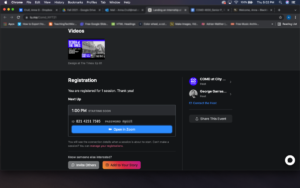 I believe a week ago I received an email from Landing an Internship at the Times: CUNY x NYT Series ‘21. I registered a little late because I have the Brooklyn College internship on the same day, but I wanted to learn more about what the NY Times expected from their interns so I took a lunch break for an hour. What better way to learn than to listen to the former interns turned full time positions.
I believe a week ago I received an email from Landing an Internship at the Times: CUNY x NYT Series ‘21. I registered a little late because I have the Brooklyn College internship on the same day, but I wanted to learn more about what the NY Times expected from their interns so I took a lunch break for an hour. What better way to learn than to listen to the former interns turned full time positions.
Takeaways from the CUNY x NYT Series ‘21 Zoom:
- Attitude goes a LONG way
- Hold yourself accountable
- Practice so Interviews feel natural not rehearsed
- Get comfortable asking questions
- Curiosity and Responsibility are two of the characteristics they are looking for
- Provide prototypes that apply to your area of design
- All four of the guest speakers started with an interest in design but not in their current areas
- “You can’t do everything. Value your own time and work, passion can exist in both places” – Jamie Liao
- “There are many variations of designers, try things out and find your passion” – Jeanie Kay
If you are interested in working for The New York Times check out these two link for future jobs: https://www.nytco.com/careers/
https://nytimes.wd5.myworkdayjobs.com/en-US/Intern-Biz
At 12:55, five minutes before 1pm on Thursday the 18th of November I joined the Zoom. I took a lot of notes so hopefully I get this all correct.
Nya is one of the coordinators and hosts on the NYTimes series team and Professor Garrastegui is the CUNY City Tech coordinator and host. I remember Nya from last semester when I was able to attend one of the series. Because I attended one series last semester I was a part of the email chain that received notification for this semester’s series.
In addition the COMD instagram was posting reminders of this event in their stories.
Nya briefly introduced us to four employees of the NYT, Jeanie Kay, Tina Ye, Jenni Lee, and Jamie Liao. Jeanie has 5 plus years of experience and Tina mentioned being on the publishing team almost two years.
Jenni and Jamie were former interns and now hired as full time positions. They are in different departments but their teams sometimes work together which allows them to remain in the same social group.
Both of the former interns agree there are two differences from intern to full time:
- Once full time, projects are longer term
- You work closer with the people around you
As an intern Jamie suggested connecting with as many people as you can because you are aware the internship will end. Whereas when you become full time you develop a closer relationship with the team. Mingling becomes less of an urgency because you are building with the team you see daily.
A tip Tina Ye mentioned was if your portfolio is private to be SURE you add the password NEAR or next to the Url. They say too often they look over people that either forget to provide it or do not make it easily accessible.
Ye also reiterated the reason they look at portfolios is because it is hard to see the process in a resume.
Jeanie Kay mentioned comparisons and self reflection would be helpful in your portfolio. It allows the recruiters to see your thought process and the principles that drive your work. They want to see you draw conclusions from your research. Saying climate change is too broad. You need to target an area you want to solve or contribute to.
Kay said to include hobbies in your resume or on your website because they show what you are interested in. I honestly did not think jobs would care what a person is into if they can get the work done well and correctly. I figured you can’t really tell a person’s personality until after they meet you in the interview phase.
I took away that you need to tell a story about yourself, which is shown in your work. Lee mentioned that trendy visuals do not solve problems. Design projects should communicate interest with a tone and personality.
Liao says being clear and concise when explaining your process. There is usually a two round interview process at New York Times, for both it is important to be able to explain why you did your projects.
Even if you have no work you are proud of from school, design something that interests you and include your process. If you are not sure where to start, search what inspires you about the artists you like.
Liao also mentioned the NY Times has a design page: https://www.nytimes.com/topic/subject/design
I have not read the design section online but I have seen it in the real physical paper. Inspiration can be drawn from what is currently being done. I tend to use Instagram and Pinterest for inspiration but Professor Goetz has mentioned design magazines, podcasts and webinars are a way to remain in the loop and inspired.
I am sure that Kay had no idea how inspirational she was since the entire zoom call was casual like a conversation but I will leave you with what she says toward the end, “Creativity you have is different than someone else’s, It will translate into inspiration. Find a space you are curious about and let it present itself to you”.



